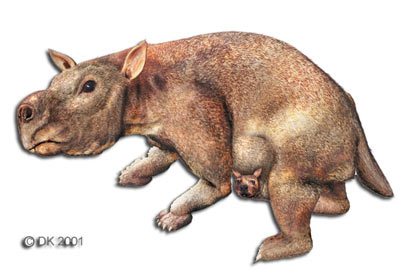Diprotodon
Diprotodon optatum
Diprotodon was the largest marsupial that ever lived.
Meaning of scientific name
Diprotodon = "two forward teeth".
Subspecies
Several species of Diprotodon have been named based on the size of the skull (Diprotodon australis, Diprotodon minor), but these are probably all males and females of one species (Diprotodon optatum).
Statistics
Shoulder height: up to 1.7m (5 ft 7in), Body length: 3m (10ft) from nose to tail. Weight: males 2000 to 2500kg; females 1000kg.
Physical Description
Diprotodon superficially resembled a rhino without a horn. Its feet turned inwards like a wombat’s, giving it a pigeon-toed appearance. It had strong claws on the front feet, so it may have been able to dig up roots to eat. Footprints of its hairy feet have been found, so we know it had fur like a horse rather than being bald like a rhino.
Distribution
Diprotodon is found in sites all over Australia, except in Tasmania.
Habitat
They inhabited forests, open woodland and scrub.
Diet
They were browsing animals, feeding on trees and shrubs. At Lake Callabonna in southern Australia, some Diprotodon have been found with saltbush in their stomachs. As this plant is not very nutritious it has been suggested that these animals were starving because of a drought.
Behaviour
They probably lived in small herds—a few dozen individuals at most.
Reproduction
Diprotodon was a marsupial. Skeletons of female Diprotodons have been found with babies in the position where the pouch would have been. The pouch probably opened to the rear of the animal, as in wombats, rather than pointing forwards like kangaroo pouches.
Conservation status
They are extinct.
Records
Diprotodons were the biggest marsupial that ever lived, weighing up to 2500kg (slightly heavier than a white rhinoceros).
History
They lived during the Pleistocene. The oldest fossils are about 1.6 million years old. They became extinct sometime between 45,000 and 25,000 years ago.
Best place to see
Diprotodon fossils and reconstructions are on display at: the South Australia Museum, Adelaide; the Riversleigh Fossils Interpretive Centre, Mount Isa, Queensland, Australia; and the Wonambi Fossil Centre, Naracoorte Caves National Park, South Australia.
Closest relative
Their closest living relatives are the wombats.

